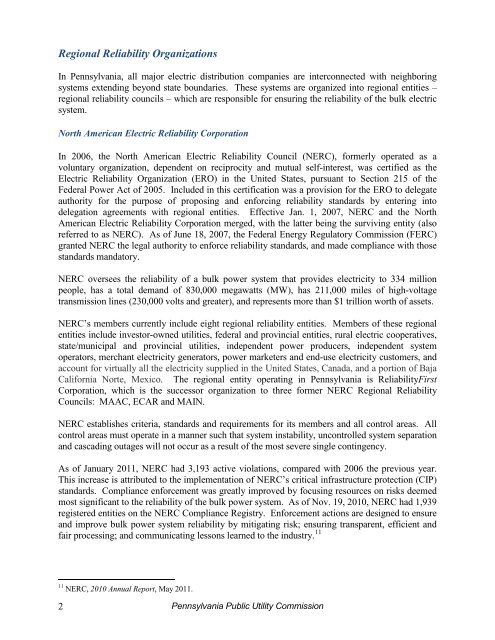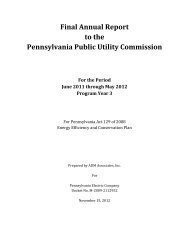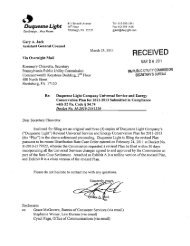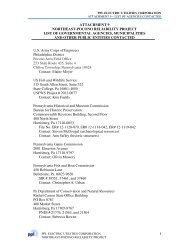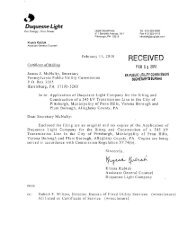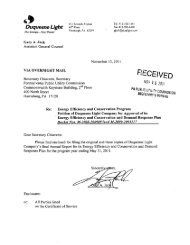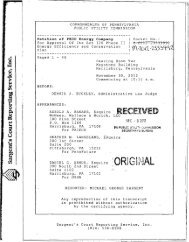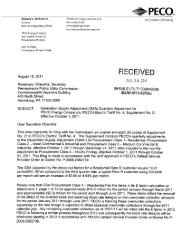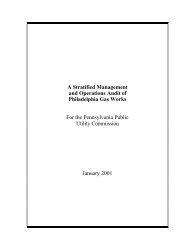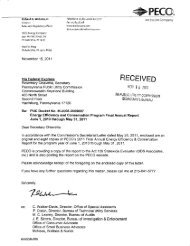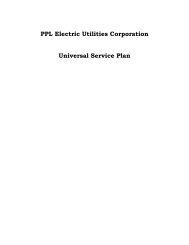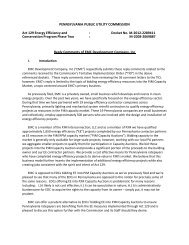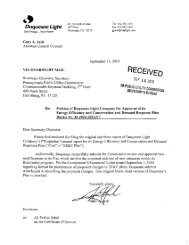Electric Power Outlook - Pennsylvania Public Utility Commission
Electric Power Outlook - Pennsylvania Public Utility Commission
Electric Power Outlook - Pennsylvania Public Utility Commission
You also want an ePaper? Increase the reach of your titles
YUMPU automatically turns print PDFs into web optimized ePapers that Google loves.
Regional Reliability Organizations<br />
In <strong>Pennsylvania</strong>, all major electric distribution companies are interconnected with neighboring<br />
systems extending beyond state boundaries. These systems are organized into regional entities –<br />
regional reliability councils – which are responsible for ensuring the reliability of the bulk electric<br />
system.<br />
North American <strong>Electric</strong> Reliability Corporation<br />
In 2006, the North American <strong>Electric</strong> Reliability Council (NERC), formerly operated as a<br />
voluntary organization, dependent on reciprocity and mutual self-interest, was certified as the<br />
<strong>Electric</strong> Reliability Organization (ERO) in the United States, pursuant to Section 215 of the<br />
Federal <strong>Power</strong> Act of 2005. Included in this certification was a provision for the ERO to delegate<br />
authority for the purpose of proposing and enforcing reliability standards by entering into<br />
delegation agreements with regional entities. Effective Jan. 1, 2007, NERC and the North<br />
American <strong>Electric</strong> Reliability Corporation merged, with the latter being the surviving entity (also<br />
referred to as NERC). As of June 18, 2007, the Federal Energy Regulatory <strong>Commission</strong> (FERC)<br />
granted NERC the legal authority to enforce reliability standards, and made compliance with those<br />
standards mandatory.<br />
NERC oversees the reliability of a bulk power system that provides electricity to 334 million<br />
people, has a total demand of 830,000 megawatts (MW), has 211,000 miles of high-voltage<br />
transmission lines (230,000 volts and greater), and represents more than $1 trillion worth of assets.<br />
NERC’s members currently include eight regional reliability entities. Members of these regional<br />
entities include investor-owned utilities, federal and provincial entities, rural electric cooperatives,<br />
state/municipal and provincial utilities, independent power producers, independent system<br />
operators, merchant electricity generators, power marketers and end-use electricity customers, and<br />
account for virtually all the electricity supplied in the United States, Canada, and a portion of Baja<br />
California Norte, Mexico. The regional entity operating in <strong>Pennsylvania</strong> is ReliabilityFirst<br />
Corporation, which is the successor organization to three former NERC Regional Reliability<br />
Councils: MAAC, ECAR and MAIN.<br />
NERC establishes criteria, standards and requirements for its members and all control areas. All<br />
control areas must operate in a manner such that system instability, uncontrolled system separation<br />
and cascading outages will not occur as a result of the most severe single contingency.<br />
As of January 2011, NERC had 3,193 active violations, compared with 2006 the previous year.<br />
This increase is attributed to the implementation of NERC’s critical infrastructure protection (CIP)<br />
standards. Compliance enforcement was greatly improved by focusing resources on risks deemed<br />
most significant to the reliability of the bulk power system. As of Nov. 19, 2010, NERC had 1,939<br />
registered entities on the NERC Compliance Registry. Enforcement actions are designed to ensure<br />
and improve bulk power system reliability by mitigating risk; ensuring transparent, efficient and<br />
fair processing; and communicating lessons learned to the industry. 11<br />
11 NERC, 2010 Annual Report, May 2011.<br />
2<br />
<strong>Pennsylvania</strong> <strong>Public</strong> <strong>Utility</strong> <strong>Commission</strong>


